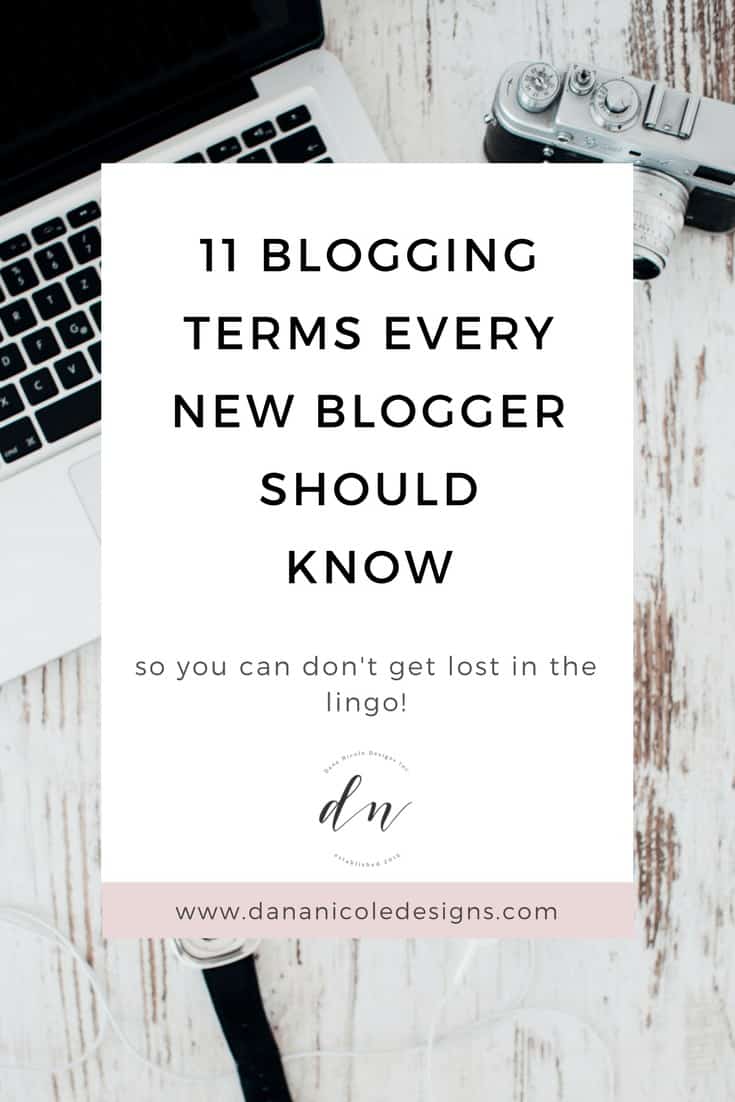Last Updated on
If you’re new to blogging, there is a chance you have probably come across a few of these words, and if you haven’t come across them yet, you definitely will!
I can remember the days before I got involved with online marketing and blogging, and many of these terms were ones that I was not familiar with myself.

However, knowing some basic blogging lingo will help you understand any tips and strategies you are reading online when it comes to growing your blog, as well as talk with other bloggers and understand what everyone around you is saying!
This article contains affiliate links. If you choose to make a purchase through a link in this article I will earn a commission at no extra cost to you.
Marketing Terms
SEO: SEO stands for search engine optimization. SEO is the process of obtaining organic traffic to your website from Google and other search engines (don’t worry if you don’t know what organic traffic is yet, we are going to discuss that next)! When you start blogging, there are a few things you can do to try and get your website in the number one spot on Google for specific keywords! I have a post on simple SEO strategies that will help you get to know the basics of SEO.
Organic/Inorganic Traffic: Organic traffic is traffic that comes to your website without paying for ads. So basically, it’s free traffic. Inorganic traffic (also known as paid traffic) is traffic that has come to your website or blog in result of an ad you have paid for.
Inbound Marketing: Inbound marketing is drawing your readers into your blog via SEO, social media marketing or other initiatives.
Outbound Marketing: Marketing that “interrupts” your users such as commercials or ads.
Tech Terms
Self-Hosted: If you are thinking of blogging seriously, you will likely want to self-host. Let me explain what self-hosting is. When you first start out your blog, you may be using a free version of WordPress, Blogger, Wix or any other platform.
Now, if you plan to take your blog seriously (it’s more than just a hobby) you will want to consider self-hosting. Self-hosting means that you own your content and you pay a company a small fee to keep your website running. It’s a LOT less complicated than it sounds, and most people who have a website are self-hosted.
If your website has “WordPress.com” in the URL, then you aren’t self-hosted. I use Siteground for hosting and recommend it to all my clients. It’s one of the cheaper hosting platforms (plans start at $6.99 a month) on the market but is incredibly reliable and ensures your website runs quickly and smoothly. If you want to make any money from your website, you will need to be self-hosted. I wrote an in-depth article on how to start a blog on WordPress that will walk you through all the steps you need to get set up with hosting and WordPress!
CMS: CMS stands for Content Management System, and is the platform you are blogging on. For example, this website was made on WordPress, therefore my CMS is WordPress. You could be on Wix, Squarespace, Blogger, Joomla or any other CMS.
HTML: HTML stands for hypertext markup language and is used to create web pages and blogs. I have an HTML cheat sheet that you should definitely add to your favourites so you can go back and view it when the time comes. If you are just starting out, you may not need to dive into HTML right away, but there may come a time when having a little HTML cheat sheet available will be beneficial!
CSS: CSS stands for cascading style sheet and like HTML, it is used to create web pages and blogs. CSS tells the HTML how it should look. For example, if I wanted to change the color of the text on my website, I’d use CSS. Anything that has to do with “styling” is handled by CSS (i.e. text alignment, colors, fonts etc). Don’t worry about learning HTML or CSS right now – just be aware of what they are!
Permalink: A URL is the address of your blog or website, and a permalink is a link to a specific blog post or page. For example, my URL is www.dananicoledesigns.com. The permalink for my services page is www.dananicoledesigns.com/services.
Theme: If you are using WordPress, you will need to pick a theme. The theme is how your website looks, and WordPress offers a variety of premium (ones you have to pay for) and free themes!
Miscellaneous Blogging Terms
Affiliate Income: Affiliate income is one popular way that some bloggers monetize their blogs. Affiliate links are product-links that are unique to a specific blogger, and if one of their reader’s clicks on the links and makes a purchase, that blogger will earn a small commission.
Lead Magnet (or freebie/opt-in/upgrade): A lead magnet (or freebie/opt-in/upgrade) is a piece of content that is related to a particular page or blog post, that a user can download for free (usually in exchange for an email address). Lead magnets collect leads (aka email addresses) in order to build a blogger’s email list. Here are 16 ideas for your next opt-in.
Email List: An email list is a collection of emails (aka subscribers). An email list is very important to have as it helps you grow your blog, get traffic to your blog and allows you to connect with your audience. If you are just starting out, you are going to want to get started on your email list. I have a post on starting an email list from scratch that you may find very helpful!
This article may include affiliate links. As an Amazon Associate I earn from qualifying purchases.

Dana Nicole is an award-winning freelance writer for MarTech/SaaS who was rated one of the best SaaS writers by Software World. She specializes in writing engaging content that ranks high in search engines and has been featured in publications like Semrush, ConvertKit, and Hotjar.
Dana holds a Bachelor’s degree in Business Administration and has over 15 years of experience working alongside national brands in their marketing departments.
When Dana’s not working, you can find her dancing en pointe, cooking up new recipes, and exploring the great outdoors with her two big dogs.

